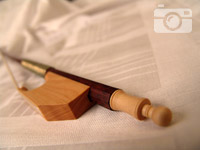The world of bows, just like that of the violins, is diverse and fascinating. Few are aware that bow making is akin to the making of any instrument in its complexity, use of wood and tools. With a good quality bow made of good material the instrument sounds much better, incredible as it may seem. Musicians choose their bows based on rapport as well, not only depending on the technique used when playing. This means that in the hands of a particular musician a particular instrument will sound best only with a particular bow.
In the early middle ages the development of bow making , and improvement of its quality was not regarded as being significant. Later, however, as the instrument developed, these started to improve too. To me the renaissance and baroque bows are the most enthralling, because they shelter the freedom, for example of form, that these times suggest in their art and way of thinking. The joie de vivre of The Renaissance, the delirious joy and playfulness of baroque can come to life in a way that the rules of making a bow are not broken and the beauty, the gracefulness and the yielding of the forms is not to the detriment of its use.
Today's modern bows are more unified in form, weight and length. The new age calls for new sound and new use. The modern way of making bows has accommodated this need, and has become a separate branch in instrument making. I love working with snake-wood the most. I have been mesmerized by its beauty and boisterousness. In my profession I have arrived to the point where I have started to hear what the greatest master, the wood, suggests. Listening to it, I sense how to make bows that are truly functional and practical from particular materials.

